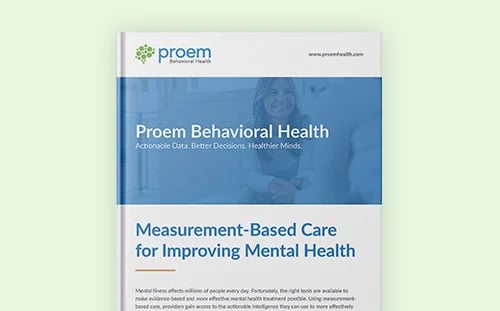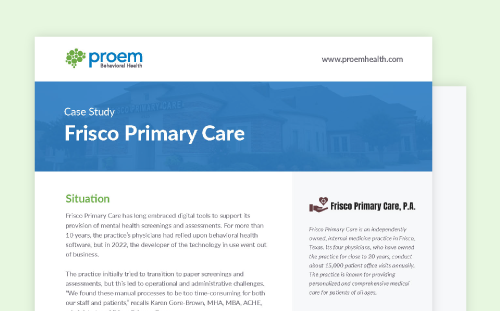For years, health care experts have advocated integrating behavioral health care into primary care. The practice is being promoted by Substance Abuse and Mental Health Services Administration (SAMHSA) and is covered by Medicare and some private insurance.

Even so, this change still represents a significant paradigm shift for primary care physicians, and some primary care professionals may be asking: What are the goals of integrated behavioral health care? The goals of SAMHSA’s integrated behavioral health initiatives and similar initiatives are actually closely aligned with what most primary care providers want for their patients.
Here are some of the most significant goals of integrated behavioral health care.
1. Foster Collaboration Between Behavioral Health and Primary Care
The primary goal of integrated behavioral health is to foster collaboration between primary care and behavioral health providers.
Experts are increasingly realizing the effectiveness of health care that synchronizes primary and behavioral health. Often, physical and behavioral conditions affect each other and must be treated in tandem for the best results. However, our current health care system often silos primary care and behavioral health care, forcing patients to settle for a fractured, less effective approach.
In recent years, SAMHSA has begun encouraging collaboration between primary care and behavioral health. As a SAMHSA integrated behavioral health statement explains, “Persons with any mental illness are more likely to have chronic conditions such as high blood pressure, asthma, diabetes, heart disease and stroke than those without mental illness … Similarly, persons with physical health conditions such as asthma and diabetes report high rates of substance use disorders and serious psychological distress.”
"However,” the statement goes on to say:
“distinct and specialized care systems and financing structures continue to result in often uncoordinated identification, diagnoses and treatment of behavioral health and physical health conditions.”
As a result, patients with both physical and behavioral health conditions see notably worse outcomes and experience shorter lifespans.
The issue can be tackled with an integrated behavioral health care approach to primary care and a corresponding program that reimburses providers for costs associated with delivering integrated behavioral health care. This program is behavioral health integration (BHI).
Integrated care opens the lines of communication between primary and behavioral health practitioners. This fosters collaborative relationships that allow for mutual learning and support, ultimately helping both primary care and behavioral health providers treat patients more effectively and efficiently.
2. Promote Better Health Outcomes
Current approaches to health care that separate primary care and behavioral health care result in quantifiably worse health outcomes for patients.
In many cases, patients with symptoms of a behavioral health condition are referred by their primary care doctor to a specialist. Unfortunately, many people referred to behavioral health professionals don’t follow through and ultimately don’t receive care.
When patients receive behavioral health diagnoses and treatment, data shows that siloed health care still results in worse outcomes. For example, patients with behavioral health diagnoses use more medical resources and are more likely to be hospitalized for medical conditions than those without. A study by the American Psychiatric Association found that overall spending for patients with comorbid mental health or substance abuse issues is 2.5 to 3.5 times higher than for those without these issues. Despite that higher spending, the life expectancy for people with major mental health diagnoses is 7 to 24 years shorter than those without such diagnoses.
It doesn’t need to be this way. A review of 79 trials of collaborative care found the integrated behavioral health care model significantly improved outcomes for patients with depression and anxiety. In fact, a hospital in Salt Lake City found that integrating behavioral health into primary care saved $115 per patient per year and resulted in 23% fewer emergency room visits, 11% fewer hospitalizations and 76% fewer primary care visits.
The data suggests that integrated behavioral health care leads to better health outcomes. This important goal — along with significant reimbursement using CPT codes for BHI services — is driving much of the push for primary care providers to adopt the integrated approach.
3. Provide More Preventive Behavioral Health Screening
The medical community broadly recognizes the importance of preventive care. Preventive screening helps primary care physicians catch ailments early and treat them before they become more serious. The same principle can be applied to behavioral health, but rarely is it.
A lack of preventive behavioral health care means there’s an average delay of 11 years between the initial onset of a behavioral health condition and when a patient starts seeking treatment. During those 11 years, patients experience significant suffering, their conditions may worsen, and they may deal with secondary effects like poor physical health or damage to their personal lives. Many of these consequences could be lessened with more preventive behavioral health care.
Integrated behavioral health care is needed to ensure the proper tools and approaches are used when screening for behavioral health conditions. Behavioral health integration facilitates this, making it possible for thorough and accurate screening to become a routine part of preventive care that’s reimbursed by Medicare and commercial insurance.
4. Address Behavioral Health Concerns Quicker
When patients experience behavioral health concerns, they often need to make an appointment with a specialist. In the process, weeks can be lost due to scheduling delays. In many cases, a patient’s preferred specialist may not take their insurance or be accepting new patients, leading to greater delays.
The goal of behavioral health integration is to help patients address behavioral health concerns in a timelier manner. If behavioral health is integrated into primary care, patients will be spared the complications of needing to seek out new providers. Integrated behavioral health insurance coverage is available under Medicare and through many private insurances, so primary care providers can offer it and be reimbursed.
Most importantly, BHI means patients can receive quick responses to acute behavioral health concerns right in their primary care provider’s office, without needing to wait for a new appointment. The end result is faster, more effective treatment for patients.
Get Support for Implementing Behavioral Health Integration
What are the goals of integrated behavioral health care? From better preventive care to timelier intervention, there are more goals than we can cover here. However, all these goals come down to making patients healthier and driving evidenced-based outcomes, ultimately supporting the transition to value-based care.
With integrated behavioral health insurance coverage available from Medicare and many private insurances, adopting BHI is easier than ever. There are also technology tools primary care providers can leverage to support the screening of behavioral health conditions and follow up on the care provided. For example, Proem is the exclusive digital licensee of several behavioral health assessments providers can use to diagnose behavioral health issues and provides a solution for coordinating ongoing care, tracking progress and documenting reimbursable services.
To find out more about how the Proem workflow solution supports the delivery of BHI, book a meeting.





.png)









